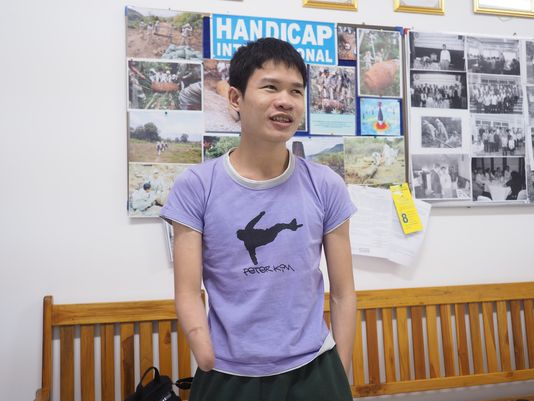VIENTIANE, Laos — Phongsavath Souliyalat was walking home from school in his tiny village of Hin Hub, a few hours north of the capital of Vientiane, when a friend found a metal ball on the ground.
“We did not know what it was, so he gave it to me. I’m a little bit naughty so I tried to open it, and that is my last memory,” Souliyalat recalled about what happened in February 2008.
The ball was a cluster bomb, one of 270 million that the United States dropped on Laos between 1964 and 1973. The baseball-sized munition exploded in Souliyalat’s hands, and the next thing he knew, he woke up in a nearby hospital. He was blind and missing both hands. It was also his 16th birthday.
Souliyalat, now 24, is one of an estimated 12,000-15,000 survivors of unexploded ordnance in Laos, a victim of a secret war conducted decades ago. While fighting in Vietnam, the U.S. conducted 580,000 bombing missions over Laos, partly to cut supply lines along the Ho Chi Minh trail, a North Vietnamese supply chain that ran to South Vietnam.
President Obama’s visit to Laos this week brought the issue into the spotlight. Declaring that the U.S. had a “moral obligation to help Laos heal,” Obama announced a new commitment to spend $90 million over three years to help deal with the unexploded ordnance problem in Laos.
While much attention has focused on the urgent need to clear the remaining bombs, Obama spoke Wednesday about the impact on the people of Laos during a visit to a rehabilitation center in Vientiane.
“For the people of Laos, the war did not end when the bombs stopped falling,” Obama said. “Eighty million cluster munitions did not explode. They were spread across farmlands, jungles, villages, rivers. So for the last four decades, Laotians have continued to live under the shadow of war.”
For Souliyalat, his simple encounter with one of those cluster bombs turned his life upside down.
“After my accident, everything changed,” he said. “I lost my school. I can’t go to work. I can’t meet people. I can’t go where I want to go. I can’t get a girlfriend.”
He spent the first two years after the accident isolated, mostly alone in his room back home in Hin Hub. He had to teach himself how to do the most basic tasks without sight or use of his hands, from opening doors to washing and feeding himself.
Beyond the physical trauma, the accident also took a major toll on his psyche. Kim Warren, head of mission with the aid group Handicap International Laos, met Souliyalat and helped get him admitted to a home for the blind near Vientiane. Warren said she found him despondent, even suicidal.
“He was so traumatized,” she said. “Angry. Every time I saw him, he would tell me, ‘Thanks for everything, but you won’t see me again.’ I was so worried that he was actually going to do it.”
Warren got him transferred to the National Rehabilitation Center, a school in Vientiane where he began learning new skills and making friends. He also learned English and has since become one of the better-known advocates for similar victims in Laos.
He’s become a peer counselor and even started a hip-hop dance troupe that he hopes could perform in the United States some day.
While Souliyalat has managed to turn his life into a positive influence, the problem of unexploded ordnance remains devastating in Laos — and disproportionately concentrated in impoverished rural areas where many people lack access to support services.
“It’s a very close link, when you look at the poverty map and overlay it with the (unexploded ordnance) contamination map. It happens in the same place,” said Thiphasone Soukhathammavong, director of the Lao National Unexploded Ordnance Program, the largest bomb-clearing operation in the country.
“These are people living at subsistence or near-subsistence level having the least access to services that are most affected,” said Simon Rea, country director for Mines Advisory Group, a bomb-clearing organization that receives most of its funding from the U.S. government.
Rea said the increased U.S. funding will allow bomb-clearance groups to finally conduct a national survey to map out the true scope of the remaining damage.
“From that information, we will be able to get some accurate estimations for timelines and for costs involved in actually conducting the clearance of all that contaminated area,” Rea said.
In the meantime, aid for victims will be needed for a long time.
“Victim assistance is an area that is underfunded,” said Bernie Chaves with Catholic Relief Services. “Accidents keep happening, and they’re going to be happening for years to come until every single bomb is out of the ground.”
Keeping victims in mind is the message that Souliyalat continues to spread: “There are many thousands of victims waiting for support in daily life, and I hope that the American government is going to support the victims as well in the future.”
Source: USA Today



